| Elastic Plastic Surgery has revolutionized lifting procedures. Elastic Plastic Surgery comprises the numerous innovative techniques made possible by the creation of a new elastic surgical thread; this thread is impalpable, does not cut into the tissues, and is transformed into "natural ligament" (Elasticum, Korpo srl). |
The elastic thread is provided with a two-tipped needle (Jano needle) which allows to perform lifting without having to dissect the tissues or with minimal or of a few cm square dissection. The elastic sutures and the Jano needle were designed by dr. Sergio Capurro (Capurro PCT) and also the operating procedures. |
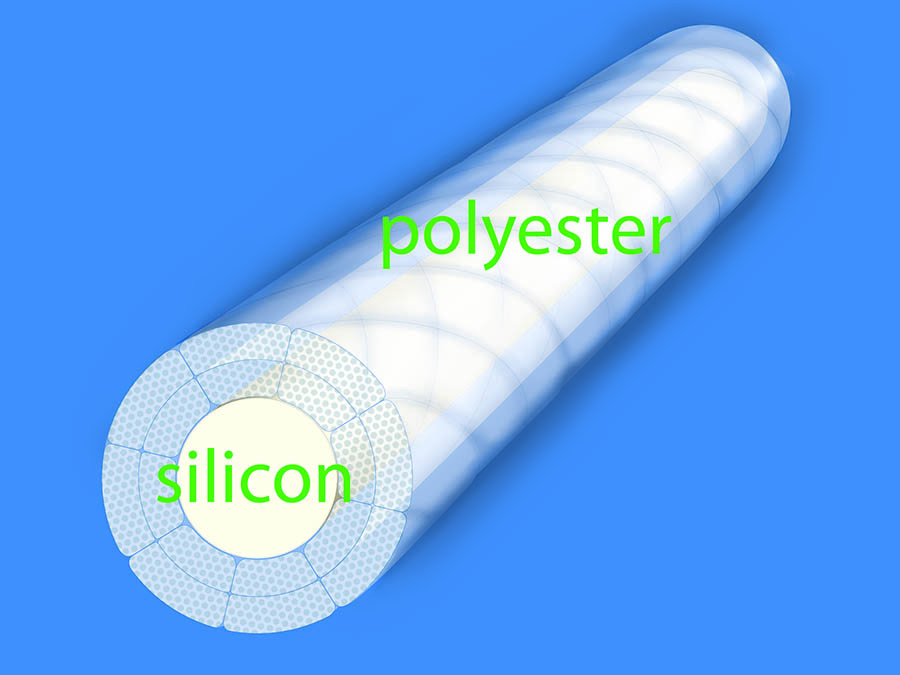
Elasticum thread
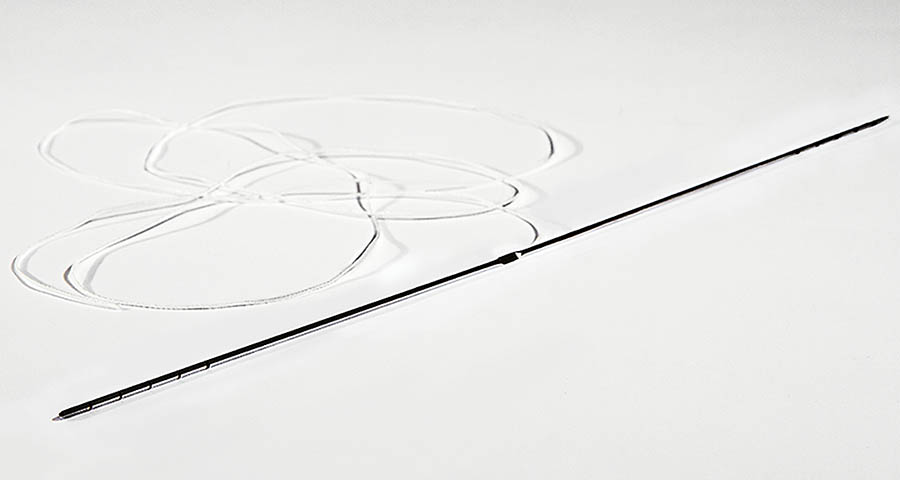
Jano needle
ELASTIC LIFTING OF THE CHEEKS
| It is no longer necessary to dissect the face in order to isolate and traction the SMAS. The stably traction and suspension of facial volumes is achieved | through the implementation of the elastic thread, without dissection and without the trophic damage that it causes. |
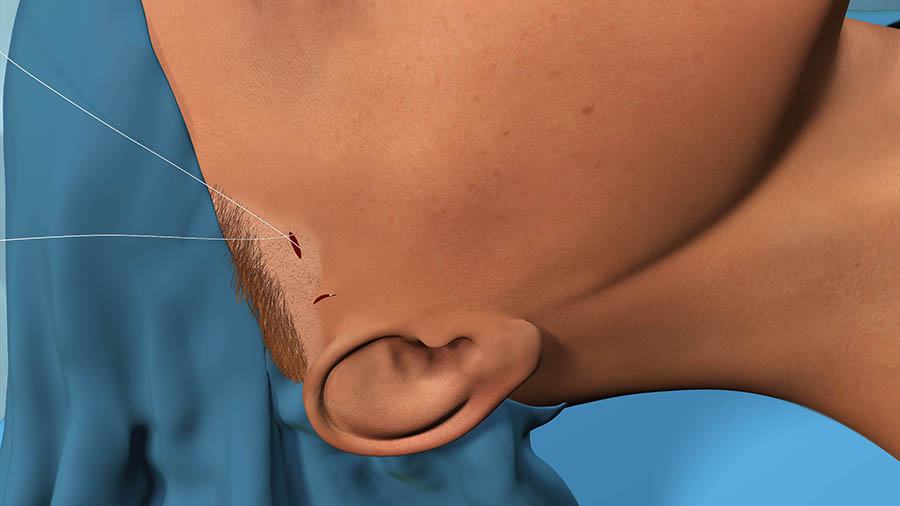
Elastic lifting of the cheeks with two incisions of a few millimeters
ELASTIC LIFTING OF MARIONETTE WRINKLES
| The elastic lifting of the marionette wrinkles is performed by a 1 cm incision behind the lobe of the two ears. | The suspensive triangle created by the elastic thread delineates the mandibular arch and reduces the wrinkles of the marionette. |
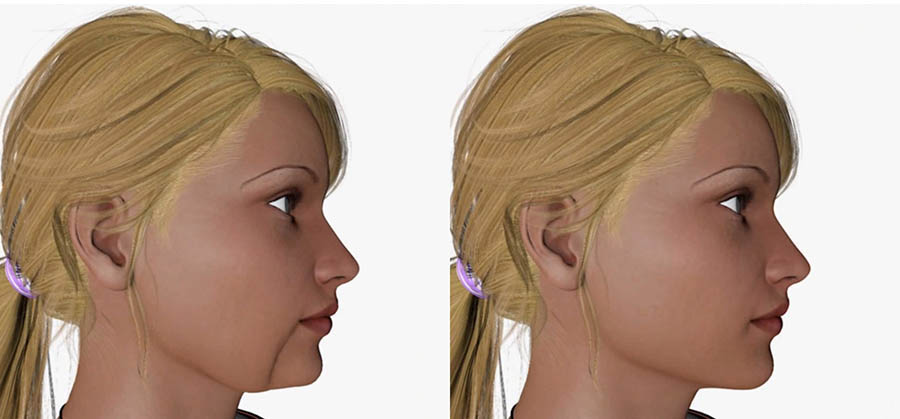
Elastic lifting of marionette wrinkles with an incision of 1 cm behind the earlobe
ELASTIC LIFTING OF EYEBROWS
| Elastic lifting of the temporal region and the eyebrows does not require tissue dissection, either; it is achieved by implanting one or two elastic threads | through an incision of a few millimeters at the hairline. At the same time you can correct the sunken temporal fossae with Adipofilling. |
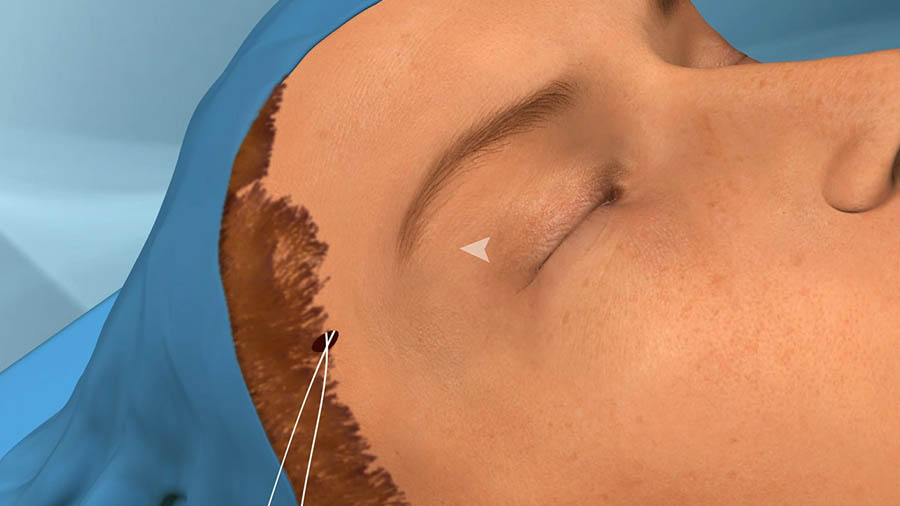
Elastic lifting of eyebrows with an incision of a few millimeters to the hairline
ELASTIC LIFTING OF THE NECK
| Nor is dissection needed in elastic neck lifting procedures. The excess skin partially covers the new cervicomandibular angle created by the elastic thread stretched between the two fasciae of Loré. | Some of the excess skin is simply repositioned at the sides of the neck, where it corrects the emaciation of the cervical region. The traction fixing to the mastoid is old and painful and should be abandoned. |
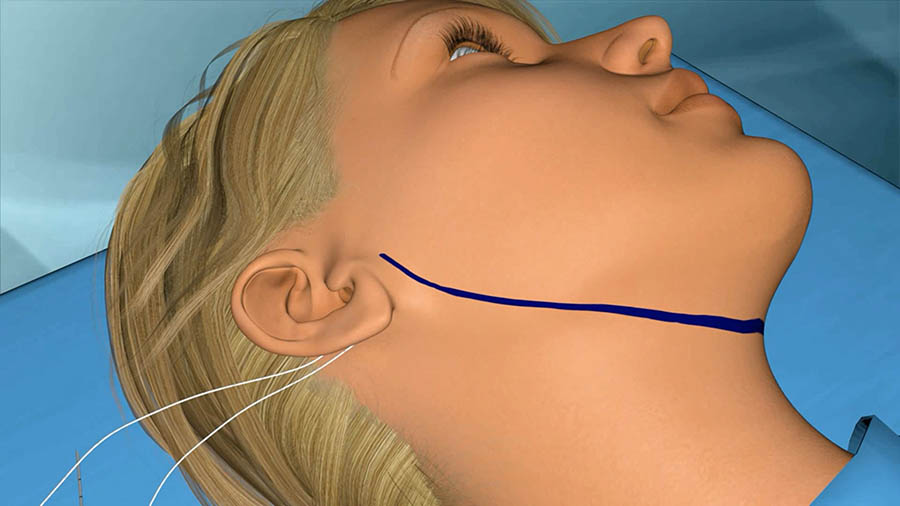
Elastic lifting of the neck with an incision of 1 cm behind a lobe of an ear
ELASTIC LIFTING OF THE NECK AND LIPOSUCTION
| The double chin is visibly improved with horizontal liposuction followed by an elastic neck lift through a 1 cm incision behind the earlobe. | In the postoperative period, the patient must wear a small band for about a month at home. |
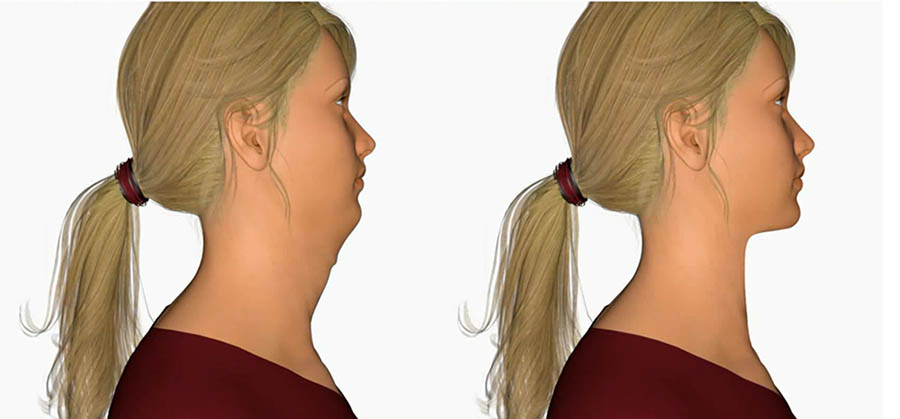
Liposuction and elastic lifting of the neck
ELASTIC LIFTING OF THE NECK WITH THE SAFETY PINS
| In patients with drooping neck skin, the procedure of choice is now elastic lifting with the aid of safety-pins. | The pins temporarily fix together at several points the two elastic threads running between the two fasciae of Loré and are replaced by stitches to prevent the recurrence of drooping. |
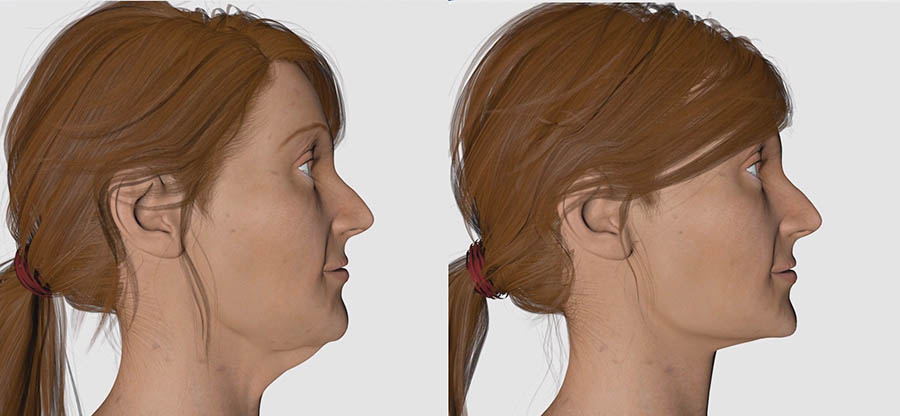
Elastic lifting of the neck with the safety pins. An incision of 1 cm behind the lobes of the ears. This facelift is suitable for necks with sagging skin.
ELASTIC MACS AND NECK LIFTING
| If the skin at the sideburns can be pinched between the fingers, elastic MACS lifting is performed. This involves making an incision that runs round the lower part of the sideburn and stops at the tragus; | dissection extending slightly beyond the zygomatic arch is carried out and three suspension triangles are created in order to lift the cheek and the malar region. Through the elastic MACS lifting incision, elastic lifting of the neck can also be carried out. |
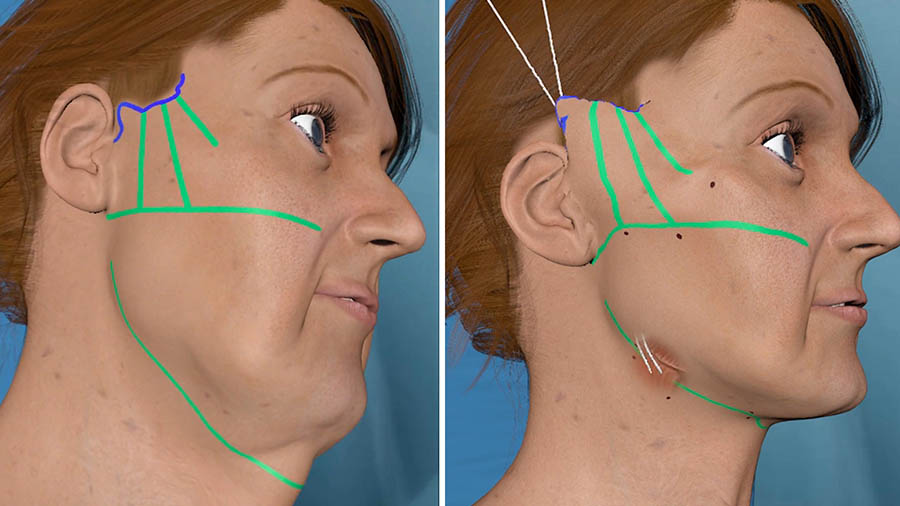
Elastic MACS and Neck lift. Incision that stops at the tragus. Dissection that slightly exceeds the zygomatic arch. Excess skin removal
ELASTIC LIFTING OF HIGH AND LOW NECK
| The elastic facelifts of the high and low neck are made by a cutaneous incision of a few millimeters lateral to the sternocleidomastoid muscle. | At the same time, it is an intradermal Adipofilling can perform to rejuvenate the damaged neck skin and remove wrinkles. |
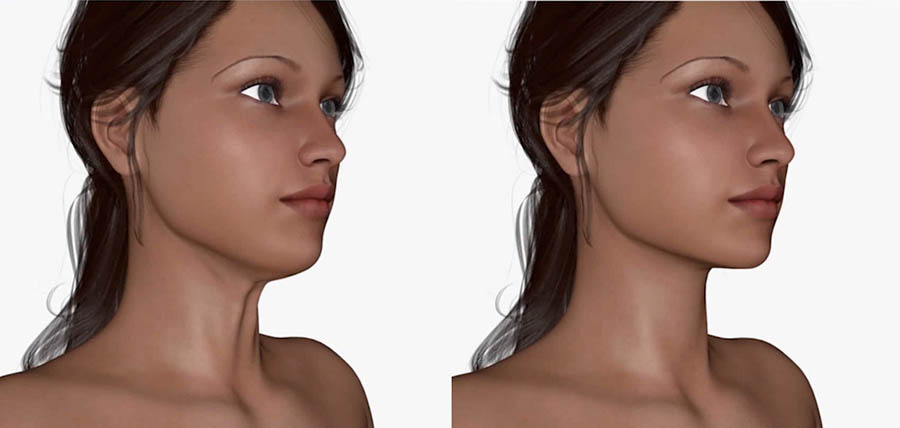
| Other procedures include: ELASTIC LIFTING OF THE UPPER LIP, ELASTIC LIFTING OF THE CHIN, ETC. Elastic lifting of the face can also be used to perfect the results of traditional lifting procedures. |
Adipofilling, another technique designed by dr. Capurro is able to restore volumes, rejuvenate aged skin and erase wrinkles, contributing to the successful restoration of symmetry and beauty. |
ELASTIC GLUTEOPLASTY
| In procedures carried out on the body, the elastic thread is able to lift and compact the buttocks by means of a 6 mm incision and a few 2 mm micro-incisions, without tissue dissection. Two elastic threads are implanted (Elasticum EP5 mounted on a Jano cannula): | one of these lifts and compacts the upper portion of the buttock; the other raises the gluteal sulcus. If the buttock is heavy or requires further shaping, a third thread is implanted. The procedure is under local anesthesia. |
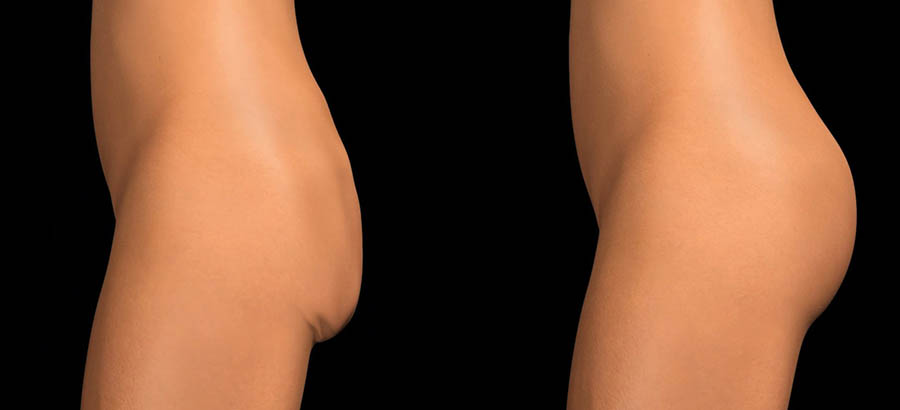
Elastic gluteoplasty. Skin Incision of 1 cm
CONIZATION AND MASTOPEXY OF BREAST WITH IMPLANTS
| Breasts that have implants can be given a more natural look by implanting two elastic threads through an 8 mm incision in the areolar margin. These threads conize the anterior portion of the breast and reduce the diameter of the areola. The breasts become firmer and look more natural. If breasts that have implants are drooping, a third elastic thread can lift them. The elastic thread raises drooping breasts (2- and 1-degree ptosis) and prevents recurrence. This procedure is carried out through an 8 mm incision in the areolar margin and a 5 mm incision close to the armpit. |
Three elastic threads are used and, as always, no dissection is needed. The elastic thread can also be used to make the breasts before grafting adipose and stromal cells (Adipofilling®). The elastic threads are also used to stabilize the breast during surgical mastopexy (3-degree ptosis). Today, surgical mastopexy can be performed without damaging the glandular tissues. This means that there is no recurrence of the ptosis seen after manipulation of the gland and the related trophic damage to the mammary tissues. Adipofilling® can further improve the appearance of the breasts. Other elastic lifting procedures concern the arms, scars, etc. |
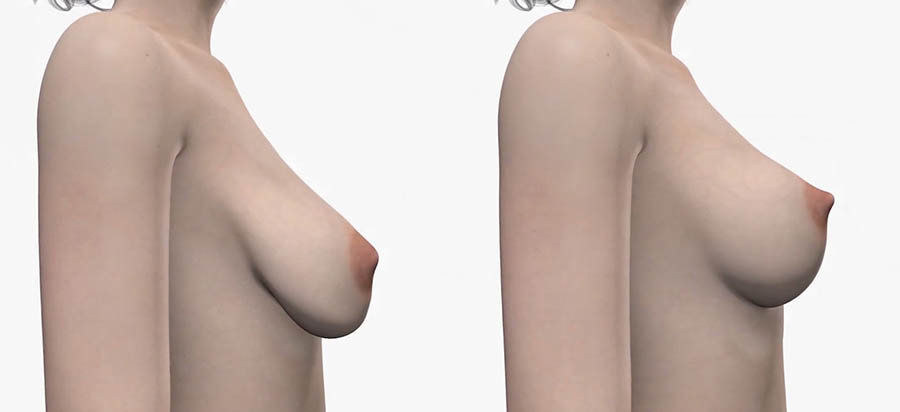
Elastic mastopexy of the breasts with implants. Two incisions of a few millimeters
All these procedures are ambulatory and require only local anesthesia
| The elastic thread was invented by Dr. Capurro (PCT). The two-tipped surgical needle was designed by Dr. Capurro in 1983 and was publicized in 1984. Subsequently, the "Jano needle" was re-patented as "atraumatic two-tipped needle" (PCT). | Elastic Plastic Surgery is a section of the open access http://www.crpub.org/. CRPUB only publishes innovative techniques in Plastic and Aesthetic Surgery, Corrective Dermatology and Phlebology. |
Since I designed the Elasticum and the Jano needle, I have not performed a traditional facelift with a dissection. I have never implanted absorbable or even partially reabsorbable or non-absorbable threads like Aptos, Contour, Infinity etc. I know the tissue very well. My father founded the Institute of Histology of the University of Genoa. Without dissection sutures and non-elastic suspensions are not suitable for permanent results. Some colleagues have had negative experiences with the non-elastic threads and throw the baby out with the bath water. I invite you to evaluate my patents, new techniques and to think about why Elasticum works, in addition to the benefits for their patients. Sergio Capurro






